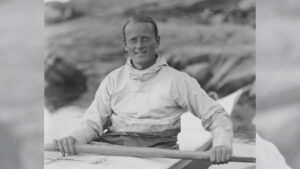When the sailors of HMS Erebus abandoned her to the ice 175 years ago, they left behind many items that weren’t necessary for survival. Then they struck out across the Arctic toward their doom.
Today, those artifacts are beginning to emerge from the icy waters of the Erebus wreck, thanks to the work of Parks Canada underwater archaeologists and Nattilik Heritage Society Inuit Guardians.
One recent noteworthy find? A leather folio, complete with pages and a feather quill.
“It’s probably the most remarkable find of the summer,” Ryan Harris, Parks Canada’s lead underwater archaeologist, told the CBC.

Parks Canada teams used remote-operated vehicles like this one to explore the HMS Erebus wreck prior to sending in manned dive teams. Photo: Aimie Neron/Parks Canada
Intriguing clues
The Franklin expedition set out from England in 1845 to find the Northwest Passage and became its most celebrated victims. Sailing from the east, they advanced quite far before making a fatal but understandable wrong turn. Locked in the ice for two years, they eventually abandoned the ships in 1848. They tried to trek to safety but perished to a man.
A series of increasingly desperate rescue missions failed to shed light upon their fate, with the exception of a few tantalizing clues: a sled with two corpses, a grave site, and rumors circulating among local Inuit groups.
Inuit oral history and traditional knowledge ended up being a key factor in eventually discovering HMS Erebus in 2014. Another team found the Erebus‘ sister ship, HMS Terror, two years later.
Both ships are in relatively good shape, as far as these things go. The frigid arctic water has a way of preserving organic relics, allowing researchers to make extraordinary finds like the Erebus steward’s journal.
“We came across a folio — a leather book cover, beautifully embossed — with pages inside. It actually has the feather quill pen still tucked inside the cover like a journal that you might write in and put on your bedside table before turning in,” Harris — who was also part of the original Erebus discovery — gushed to the CBC.
It’s anyone’s guess what sort of information the journal might contain. The divers found the book in a pantry in the steward’s cabin, so it might be a simple record of food stores. But as with all Franklin expedition finds, the mystery is appetizing. It’s hard not to hope that the pages might contain another small clue as to what, precisely, happened to the lost expedition’s crew members.
Currently, the folio is under analysis in a lab.
A race against time and elements
The notebook is one of 275 artifacts uncovered from the Erebus in 2022 as teams resume excavation after two years of COVID-related hiatus. Thanks to the Arctic’s short excavation season, divers, conservators, and Inuit Guardians had only 11 days to complete a series of 56 two-hour dives. Divers used special water-heated dive suits to protect them from the bitter aquatic temperatures as they explored the wreck.
Archaeologists excavated what they believe to be the Second Lieutenant’s cabin, Third Lieutenant’s cabin, and Captain’s Steward’s pantry. The resulting artifacts are the joint property of the Government of Canada and the Inuit Heritage Trust.

Inuit Guardians and Parks Canada Underwater Archaeology Team members at the HMS Erebus site in May 2022. Photo: Thierry Boyer/Parks Canada
In addition to the 275 artifacts, 2022’s fieldwork revealed the Erebus is continuing to deteriorate. The wreck sits in a mere 11 meters of water, and storm-driven waves and other climate-change-related conditions continue to degrade it.
The Terror is located in relatively deeper water and is more fully preserved. Given that, archaeology teams focused the entirety of the 2022 excavation season on HMS Erebus. Other items pulled from the wreck include an eyeglass lens, serving dishes, drafting tools, lieutenant’s epaulets, and other small artifacts.






